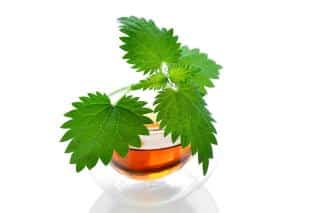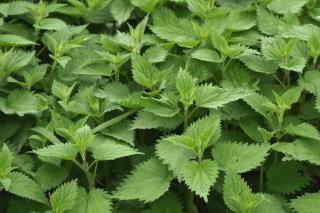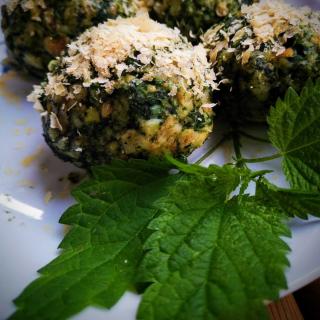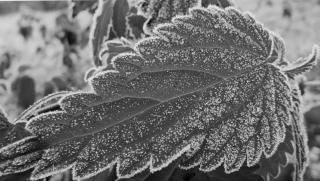Stinging nettle or Urtica dioica is a perennial herbaceous plant native to Eurasia. It has spread today to all temperate regions of the globe. This (great) weed boasts many health benefits and therapeutic properties that act upon the entire metabolism.
Health benefits of nettle
- Nettle is a diuretic and a purgative. Nettle leaves are used to prevent kidney stone formation. It greatly helps dissolve kidney stones naturally and keep them from forming. This is despite containing oxalic acid (one of the compounds that make the plant itchy).
 A great source of protein, vitamins and minerals, nettle is revitalizing and works wonders when ingested as an infusion (1 ½ oz (50 g) leaves for 1 quart (1 liter) hot water) in case of lack of energy or of iron.
A great source of protein, vitamins and minerals, nettle is revitalizing and works wonders when ingested as an infusion (1 ½ oz (50 g) leaves for 1 quart (1 liter) hot water) in case of lack of energy or of iron.
- It helps treat moderate acne and certain chronic skin conditions such as dermatitis, psoriasis and dry patches.
- Anti-inflammatory, analgesic and antimicrobial properties of nettle leaf are very effective in treating rheumatism, arthritis and gout and in case of inflammation of the urinary tract.
- Nettle increases urinary volume and flow and reduces post-voiding residual urine. It has beneficial results in case of benign prostatic hyperplasia. Since it is also antianemic, hepatoprotective and antioxidant, nettle helps treat hemorrhage (abundant menstruation, nosebleed, etc…).
- External use: Nettle offers astringent and wound-healing activity.
- Nettle appears as an ingredient in many hair lotions because it induces hair growth! It fortifies the scalp, cleanses it and reduces dandruff.
Growing nettle for its health benefits
 Nettle grows very easily when it is exposed to part sun in nitrogen-rich soil.
Nettle grows very easily when it is exposed to part sun in nitrogen-rich soil.
- Beware of snails and slugs that gleefully munch on nettles.
- No need to even try growing nettle in pots, it would produce too little.
Read also:
Cooking nettle for its health benefits
 Nettle can be eaten cooked or raw, much like spinach. Select the youngest leaves. They’ll lose their sting if you soak them in water for about ten minutes. Cooking also deactivates the “stingers”.
Nettle can be eaten cooked or raw, much like spinach. Select the youngest leaves. They’ll lose their sting if you soak them in water for about ten minutes. Cooking also deactivates the “stingers”.
- Its nutritional value makes nettle a very tonic food. , even better than spinach because it only has half as many oxalates, with only about 0.57 mg/g on average.
Nutritional content of nettle
 80 kcal / 3.5 oz (100 g).
80 kcal / 3.5 oz (100 g).
Nettle is the leaf vegetable with the highest protein content.
Together with its diuretic and antianemic properties, nettle contains minerals, provitamin A, iron and vitamin C.
Images: dreamstime: Nadya So; Pixabay: Helga, Marina Pershina, Mario, Julia Schwab


 A great source of protein, vitamins and minerals, nettle is revitalizing and works wonders when ingested as an infusion (1 ½ oz (50 g) leaves for 1 quart (1 liter) hot water) in case of lack of energy or of iron.
A great source of protein, vitamins and minerals, nettle is revitalizing and works wonders when ingested as an infusion (1 ½ oz (50 g) leaves for 1 quart (1 liter) hot water) in case of lack of energy or of iron. Nettle can be eaten cooked or raw, much like spinach. Select the youngest leaves. They’ll lose their sting if you soak them in water for about ten minutes. Cooking also deactivates the “stingers”.
Nettle can be eaten cooked or raw, much like spinach. Select the youngest leaves. They’ll lose their sting if you soak them in water for about ten minutes. Cooking also deactivates the “stingers”.
Thanks for digging up that link to the Polish study! You said: “rates are about half as high for Urtica dioica, at around 570 mg/g.” — I think you meant 0.57 mg/g, right? I’m just curious where you got that rough estimate? When I calculated the average mg/g for the stems and leaves of their samples (in Table 3) I got 0.46mg/g (aka 0.46%) by fresh weight. Close enough, anyway. Nice to see some hard data on it! Thanks for the response.
Hello Casey, of course traditional medicine recommends it, but there is science to it as well. Nettle not only blocks/slows stone formation, it has been shown to reduce and dissolve the stones, at least in live rats.
I did the same computation you did, but restricting myself to leaves which is what people typically eat or make tea from.
Also — is the idea of using nettle to dissolve kidney stones coming from a traditional medicine perspective, or is there science behind that as well?
Hi — you state that nettles have no oxalates, but this does not seem to be correct. This (unsourced) page claims 8%: https://www.kidneyurology.org/nettle-leaf/
…and while I could not find hard data on that figure, there are certainly some oxalates in nettles, as evidenced in this study: https://www.ncbi.nlm.nih.gov/pmc/articles/PMC2803540/
Oops — that second link is Urtica thunbergiana, not dioica… however I believe have seen other references?
You are indeed correct that Urtica dioica does contain oxalates. In the research you cite, which is seemingly the only one done on the subject, the cousin species U. thunbergiana contains around 1.2 mg/g, similar to spinach, but they didn’t measure it for Urtica dioica, which is much more common in Europe. Another study (in Poland, “Variation in the Content of Bioactive Compounds in Infusions Prepared from Different Parts of Wild Polish Stinging Nettle (Urtica dioica L.) by Magdalena Jeszka-Skowron, Agnieszka Zgoła-Grze´skowiak , Robert Frankowski , Tomasz Grze´skowiak and Anna Maria Jeszka) collected data showing rates are about half as high for Urtica dioica, at around 570 mg/g. It’s interesting that this question is only being answered now – the Polish article is dated to June 2022, just a year ago.
I amended the article to clarify the information – it’s still true that nettle is better than spinach, since it only contains half as many oxalates! Interestingly, the content of oxalates seem to not interfere with a key health benefit of Urtica dioica, which is precisely to help eliminate kidney stones…